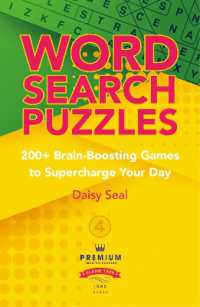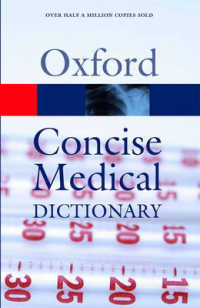Full Description
Principles and Methods of Adapted Physical Education, 13th Edition With HKPropel Access, continues its legacy as an evidence-based resource for undergraduate- and graduate-level students training to work with individuals with disabilities in a physical education setting. The content and strategies presented help educators dive deeply into how to build a successful program for the teaching of adapted physical education.
This edition incorporates the Adapted Physical Education National Standards and addresses contemporary issues confronted by teachers today:
Culturally responsive teaching strategies to help educators build learning environments where all students feel a sense of belonging
Social-emotional learning and trauma-sensitive teaching, in alignment with the Collaborative for Academic, Social, and Emotional Learning (CASEL) framework
Technology use in adapted physical education to assist in daily planning, teaching, and assessment strategies
Positive behavioral interventions and supports within an adapted physical education context
Authored by experienced adapted physical education practitioners and teacher trainers, Principles and Methods of Adapted Physical Education emphasizes understanding teaching methods and applying those methods when teaching students with disabilities. Practical instruction is offered for completing comprehensive evaluations, developing individualized education programs (IEPs), facilitating least restrictive learning environments, incorporating universal design for learning, understanding legal requirements, understanding safety considerations for specific disabilities, and determining core elements of a successful adapted physical education program.
After establishing the methodology for teaching, chapters are devoted to specific populations, including those with intellectual and developmental disabilities, autism spectrum disorder, specific learning disabilities, emotional disturbance, physically disabling conditions, deafness and hard of hearing, and visual impairments, including deafblindness.
To further support student learning, related online materials include video clips of teachers and students in action to demonstrate how activities work in real adapted physical education settings. Also included are reproducible forms from the book, which can be used for online courses or in a flipped learning format, as well as audio lectures that review key concepts from each chapter of the book.
Principles and Methods of Adapted Physical Education, 13th Edition, is the premier resource for anyone teaching in an adapted physical education setting or planning to do so.
Note: A code for accessing HKPropel is included with this ebook.
Contents
Chapter 1. Introduction to Adapted Physical Education
Definition of Physical Education in Special Education Law
Benefits of Physical Education for Learners With Disabilities
Legal Rights of Students With Disabilities
Oversight of Adapted Physical Education
Components of a Quality Adapted Physical Education Program
Adapted Physical Education Efficacy and Advocacy
Summary
Chapter 2. Determining Educational Needs Through Evaluation
Purposes of Evaluation
Legal Mandates for Evaluation and Assessment
The Evaluation Process in Adapted Physical Education
Selecting Appropriate Tests
Ongoing Assessment and Grading of Students With Disabilities
Summary
Chapter 3. Developing the Individualized Education Program
Professional Personnel Who May Be Involved in the IEP Process
Components of the IEP
Participants in the IEP Team Meeting
Agenda for the IEP Meeting
Parent Participation in IEP Process
Student Participation in the IEP Process
Ongoing Requirements for the IEP
Summary
Chapter 4. Teaching to Meet Learners' Needs
Ages and Stages: Understanding Typical and Atypical Development
Levels of Motor Function
Instructional Approaches to Skill Development
Summary
Chapter 5. Facilitating Universally Designed, Culturally Responsive, and Least Restrictive Environments
The Least Restrictive Environment and Inclusive Education
Preparing for the Least Restrictive Environment: A Proactive Approach
Universal Design for Learning
Strategies for Creating a Least Restrictive Environment for Learners With Disabilities
Culturally Responsive Learning Environments
Summary
Chapter 6. Fostering Positive Behavior and Trauma-Sensitive Spaces
Defining Problem Behavior
Positive Behavioral Interventions and Supports
Trauma-Sensitive Teaching in Adapted Physical Education
Summary
Chapter 7. Teaching With Technology
Current Research
Considerations for Selection and Use of Technology
Assistive Technology
Assessment
Instruction
Equipment
Communication
Administrative Tasks
Behavior Management and Classroom Structure
Summary
Chapter 8. Transition Planning
Transition Defined
Framework for Transition Planning
Community Sport and Recreation
Summary
Chapter 9. Infants, Toddlers, and Preschoolers
Movement Phases
Ages and Stages: Understanding Typical and Atypical Development
Developmentally Appropriate Assessment of Infants, Toddlers, and Preschoolers
Early Intervention Programs: Birth to 3 Years
Individualized Family Service Plan
Strategies for Teaching Infants, Toddlers, and Preschoolers
Preschool Programs: Ages 3 to 5 Years
Play for Children With Severe Disabilities
Responsibilities of the Adapted Physical Education Teacher
Social-Emotional Learning for Infants, Toddlers, and Preschoolers
Summary
Chapter 10. Intellectual and Developmental Disabilities
Definition
Incidence
Causes
Characteristics of Individuals With Intellectual Disabilities
The Physical Education Program
Teaching Strategies
Students With Severe and Profound Intellectual Disabilities
Summary
Chapter 11. Autism Spectrum Disorder
Incidence
Causes
Characteristics of Students With Autism Spectrum Disorder
The Physical Education Program
Summary
Chapter 12. Specific Learning Disability
Definition
Causes
Characteristics of Students With Specific Learning Disabilities
The Physical Education Program
Summary
Chapter 13. Emotional Disturbance
Definitions
Incidence
Continuum and Context of Behaviors
Types of Mental Health Conditions
Causes of Emotional Disturbance
Characteristics of Students With Emotional Disturbance
The Physical Education Program
Evaluation and Assessment
Teaching Strategies
Curriculum
Summary
Chapter 14. Physically Disabling Conditions
Definition and Scope
Neurological Disorders
Orthopedic Conditions
Traumatic Injuries
Evaluating Students With Physical Disabilities
Social-Emotional Needs of Students With Physical Disabilities
Summary
Chapter 15. Deafness and Hard of Hearing
Educational Philosophies for Working With Students With Hearing Loss
Deaf Community and Culture
Definition
Incidence
Identifying Hearing Loss
Levels of Hearing Loss
Onset of Hearing Loss
Anatomy of the Ear
Causes and Types of Hearing Loss
Characteristics of Students With Hearing Loss
The Physical Education Program
Placement
Curriculum Design
Teaching Strategies
Summary
Chapter 16. Visual Impairments, Blindness, and Deafblindness
Definition of Visual Impairment
Incidence of Visual Loss
Preventing Vision Loss
Causes of Vision Loss
Characteristics of Students With Vision Loss
The Physical Education Program
Deafblindness
Summary
Chapter 17. Other Health Impairments
Asthma
Attention-Deficit/Hyperactivity Disorder
Cystic Fibrosis
Diabetes
Dwarfism
Sickle Cell Disease
Speech and Language Disorders
Summary
Chapter 18. Students With Significant Support Needs
Definition
Characteristics of Students With Significant Support Needs
The Physical Education Program
Teaching Strategies
Summary







